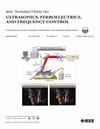Frequency-Domain Decoding of Cascaded Dual- Polarity Waves for Ultrafast Ultrasound Imaging
IF 3
2区 工程技术
Q1 ACOUSTICS
IEEE transactions on ultrasonics, ferroelectrics, and frequency control
Pub Date : 2025-01-28
DOI:10.1109/TUFFC.2025.3534429
引用次数: 0
Abstract
Ultrafast plane-wave (PW) ultrasound imaging is a versatile tool that has become increasingly relevant for blood flow imaging using speckle tracking but suffers from a low signal-to-noise ratio (SNR). Cascaded dual-polarity wave (CDW) imaging can improve the SNR by transmitting pulse trains, which are subsequently decoded to recover the imaging resolution. However, the current decoding method (in the time domain) requires a set of two acquisitions, which introduces motion artifacts that result in incorrect speckle tracking at high flow velocities. Here, we evaluate an inverse filtering approach that uses frequency-domain decoding to decode acquisitions independently. Experiments using a disk phantom show that frequency-domain decoding of a four-pulse train achieves an SNR gain of up to 4.2 dB, versus 5.9 dB for conventional decoding. The benefit of frequency-domain decoding for flow quantification is assessed through experiments performed with a rotating disk phantom and a parabolic flow, and through matching linear simulations. Both CDW methods improve the tracking accuracy compared to single PW imaging. Time-domain decoding outperforms frequency-domain decoding in low SNR conditions and low velocities (超快超声成像级联双极性波频域解码。
超快平面波超声成像是一种多用途的工具,越来越多地应用于斑点跟踪血流成像,但其信噪比较低。级联双极性波(CDW)成像可以通过传输脉冲序列来提高信噪比,然后对脉冲序列进行解码以恢复成像分辨率。然而,目前的解码方法(在时域)需要一组两次采集,这引入了运动伪影,导致在高流速下不正确的斑点跟踪。在这里,我们评估了一种使用频域解码独立解码采集的反滤波方法。使用磁盘幻象的实验表明,四脉冲序列的频域解码实现了高达4.2 dB的信噪比增益,而传统解码的信噪比增益为5.9 dB。通过旋转磁盘幻影和抛物流的实验以及匹配的线性模拟,评估了频域解码对流量量化的好处。与单平面波成像相比,两种方法都提高了跟踪精度。在低信噪比和低速度(≤0.25 m/s)条件下,时域译码优于频域译码,因为信噪比增益更高。相比之下,在旋转磁盘成像(1m /s)和抛物流成像(2m /s)的峰值速度较高时,频域解码优于时域解码,此时采集之间的显著散射体运动导致时域解码不完美。其解码单个采集的能力使得使用的CDW频域解码成为一种有前途的方法,可以提高信噪比,从而提高高速流量量化的准确性。
本文章由计算机程序翻译,如有差异,请以英文原文为准。
求助全文
约1分钟内获得全文
求助全文
来源期刊
CiteScore
7.70
自引率
16.70%
发文量
583
审稿时长
4.5 months
期刊介绍:
IEEE Transactions on Ultrasonics, Ferroelectrics and Frequency Control includes the theory, technology, materials, and applications relating to: (1) the generation, transmission, and detection of ultrasonic waves and related phenomena; (2) medical ultrasound, including hyperthermia, bioeffects, tissue characterization and imaging; (3) ferroelectric, piezoelectric, and piezomagnetic materials, including crystals, polycrystalline solids, films, polymers, and composites; (4) frequency control, timing and time distribution, including crystal oscillators and other means of classical frequency control, and atomic, molecular and laser frequency control standards. Areas of interest range from fundamental studies to the design and/or applications of devices and systems.

 求助内容:
求助内容: 应助结果提醒方式:
应助结果提醒方式:


